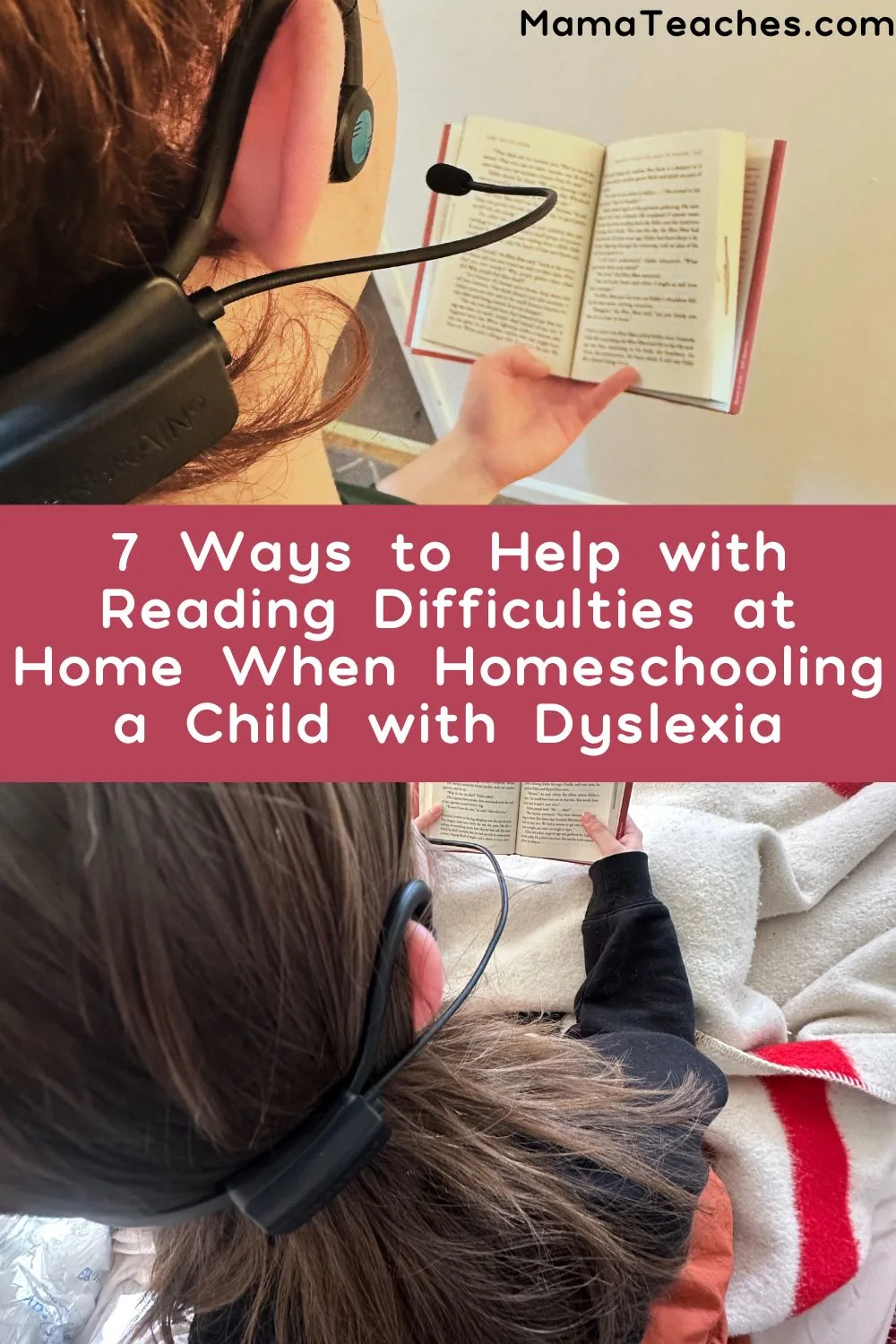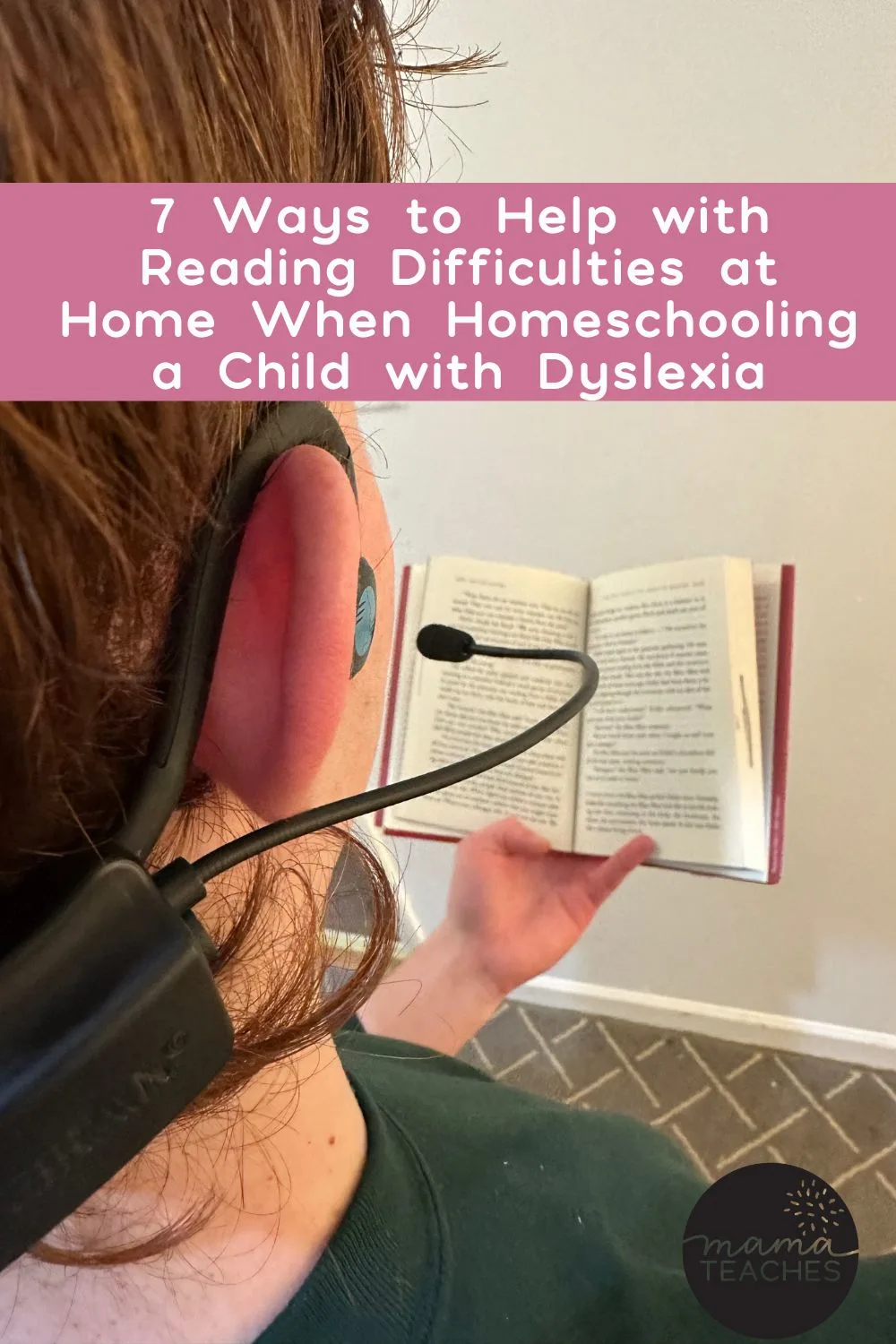Homeschooling a child with dyslexia can present unique challenges. However, with the right strategies and resources, you can create a supportive learning environment that helps your child thrive.

This article contains affiliate links to things that you might like.
As I have mentioned before, my oldest son has dyslexia, dysgraphia, dyscalculia, and ADHD.
It sounds like a lot – and it is! – but the learning challenges often co-occur, so it’s not as surprising as it may sound.
If you are homeschooling a child with dyslexia, you may have discovered that they also have a co-occurring disorder. Or maybe they don’t!
Dyslexia presents in unique ways for everyone who has it, and the same goes for dysgraphia and dyscalculia, as well.
In fact, In this article, we will discuss seven effective ways to assist your child with dyslexia during homeschooling.
Because when you’re homeschooling a child with dyslexia, having multiple teaching tricks up your sleeve can come in handy!

Disclaimer: I was compensated for my time to write this article. All opinions are my own.
Understanding Dyslexia
It is essential to educate yourself about dyslexia so that you can better support your child.
Dyslexia is a learning disorder that affects reading, writing, and spelling skills.
By understanding the nature of dyslexia, you can approach your child’s education with empathy and patience.
One of my favorite books about dyslexia is Overcoming Dyslexia by Sally Shaywitz. It’s a long read, but the audiobook version is terrific too!
Multisensory Learning
Utilize multisensory teaching methods that engage different senses simultaneously.
Incorporate visual aids, hands-on activities, and auditory cues into your lessons.
This approach can help your child reinforce their learning and improve their retention of information.
In fact, I would stress that multisensory learning is not optional when you’re homeschooling a child with dyslexia.
You have to introduce materials in different ways and give your child multiple opportunities to learn in them.
Personalized Instruction
Tailor your instruction to meet your child’s specific needs.
Dyslexic learners often benefit from individualized attention and instruction.
Identify their strengths and weaknesses and adapt your teaching style accordingly.
This personalized approach can boost their confidence and motivation.
Even if you are homeschooling multiple children at once, take the time to work one-on-one with your child with dyslexia to give them the added support they need.

Assistive Technology
Leverage assistive technology tools designed for dyslexic learners.
There are numerous apps, software, and devices available that can assist with reading, writing, and organization.
These tools can enhance your child’s independence and enable them to overcome challenges more effectively.
Audiobooks are also a wonderful addition to any homeschool as they provide access to material that might be challenging to read and comprehend while navigating dyslexia.
Remember that ear reading is not cheating!
Use Forbrain
I wanted to share something unique that’s been helping my child with dyslexia and ADHD.
It’s called Forbrain, and it’s been a game-changer for us.
You know how sometimes kids with dyslexia and ADHD struggle with speech, attention, and memory?
Well, Forbrain uses some fancy technology based on decades of research to tackle those challenges.
I’ll admit that I was skeptical, but it has really worked for my son!
One of the things I love about Forbrain is that it’s super easy to use at home.
There’s no need for extra effort or complicated training.
My child can simply put on the device while reading out loud or going through a lesson.
It’s like their own little secret weapon!

Forbrain has this cool thing called a dynamic filter that keeps their brain alert and focused.
It helps reduce distractions, which is a huge win in our house.
Plus, the bone conduction technology enhances their voice, so they can hear themselves more clearly.
It’s a little bit like magic!
Since he started using Forbrain, I’ve noticed improvements in my child’s speech fluency and comprehension.
He’s able to stay more focused and retain information better. That has been HUGE for him!
If you’re thinking of giving Forbrain a try, I recommend using it for just 15 minutes a day.
Start with 6-8 weeks of regular practice, followed by a break for a month. Then, you can repeat the cycle as needed.
Of course, if your child has a speech therapist, it’s always a good idea to consult with them for personalized advice as well.

Get Forbrain at a 10% discount on their online price of $299. Enter discount code IHN10 to get 10% off. This is a limited period offer, lasting until December 31, 2023. Buy here!
If your child could use a little boost in speech, attention, and memory, check out Forbrain.
It’s been an unexpected game-changer for us, and I hope it can do the same for you and your child, too.
Break Tasks into Manageable Chunks
Complex tasks can be overwhelming for children with dyslexia.
Break down assignments into smaller, more manageable chunks.
This approach helps prevent your child from feeling overwhelmed and fosters a sense of accomplishment as they complete each segment.
Create a Supportive Environment
Establish a supportive and nurturing environment at home.
Encourage open communication, celebrate achievements, and provide positive reinforcement.
I know it can be challenging to homeschool a child with dyslexia, but the safe atmosphere you provide for them to learn is one of the most important things you can do.
By fostering a safe and encouraging atmosphere, you can boost your child’s self-esteem and motivation to learn.
Dyslexia Home Remedies? More Like Dyslexia Supports!
Homeschooling a child with dyslexia requires understanding, patience, and tailored strategies.
By implementing these seven techniques, including the use of Forbrain, you can create an effective learning environment that enables your child to thrive academically and emotionally.
Remember, every dyslexic learner is unique, so it’s vital to adapt these strategies to meet your child’s individual needs.
With dedication and support, you can help your child with dyslexia reach their full potential in their homeschooling journey.
